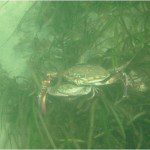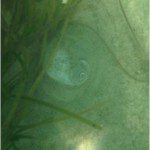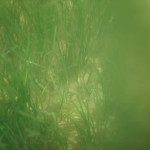Eelgrass
Eelgrass (Zostera marina) ecosystems are a vital part of coastal embayments. Unfortunately the eelgrass ecosystem of Cape Cod Bay has received relatively little attention despite the growing concern for the health of this area. Little is known about the fine-scale distribution of eelgrass in the bay, the historical trends in abundance, the function, or the production of this valuable resource.
In shallow coastal areas such as certain regions of Cape Cod Bay, eelgrass is fundamental in structuring the resident flora and fauna. Seagrass systems are highly productive producing on average between 200 to 600 g C per square meter per year (Mann, K.H. 2000. Ecology of Coastal Waters, 2nd Edition. Blackwell Science Inc., Malden, MA. 406 pp). Some of this production is utilized by organisms that feed directly on fresh material; however, the majority of eelgrass dies thereby forming an important component of the detrital food web.
As a system, eelgrass beds are extremely important biologically. They act as a refuge and nursery for juvenile fish and shellfish, many of which are commercially important species in this region. The individual eelgrass blades function as an important substrate, being colonized by a diverse community of epiphytic flora and fauna. Because of these attributes, eelgrass beds typically support a higher diversity and abundance of marine life compared to surrounding unvegetated areas (Heck, K.L., Jr., K.W. Able, M.P. Fahay, C.T. Roman. 1989. Fishes and decapod crustaceans of Cape Cod eelgrass meadows: species composition, seasonal abundance patterns and comparison with unvegetated substrates. Estuaries 12:59-65).
Seagrasses are equally important from a purely physical perspective in that they help to prevent erosion by stabilizing sediments with their extensive root systems as well as aid in filtering contaminants from the water column.
Despite the obvious value of eelgrass ecosystems, eelgrass beds are threatened by a number of anthropogenic perturbations. Declines in seagrass populations have been linked to physical disturbances (i.e., dredging, construction, shellfishing, propeller damage from boating), turbidity (i.e. topsoil runoff, activities that resuspend sediments), pollution, and most notably, eutrophication as a result of nutrient loading.
Beginning in 2007, the Cape Cod Bay Monitoring Program began incorporating eelgrass research. Studies have focused on aerial mapping with the support of LightHawk, documentation of threats, measurement of environmental parmeters, and characterization of habitat.







